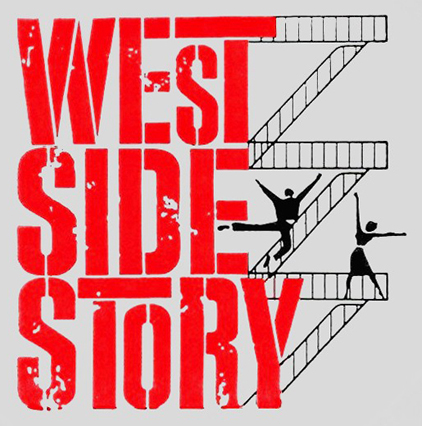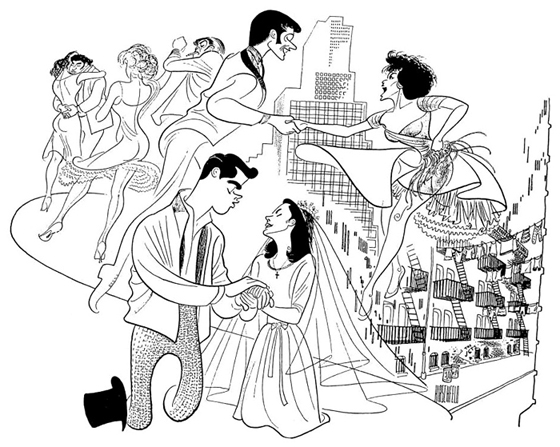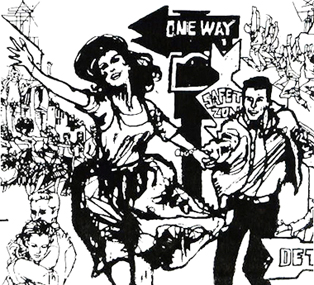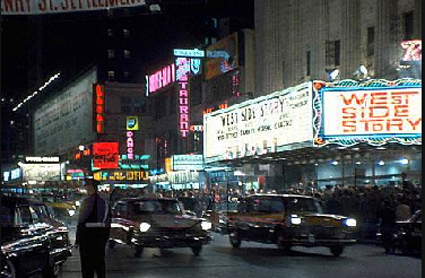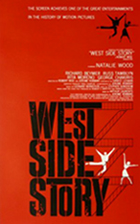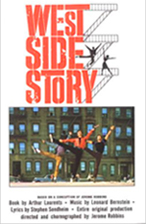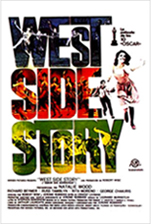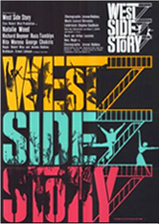1961 Roadshow Feature
WEST SIDE STORY
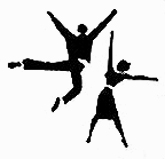
WEST SIDE STORY opened on Broadway at the Winter Garden Theatre on September 26, 1957. It ran for 732 performances - just short of two years, moving across the street to the bigger Broadway Theatre for nine weeks in 1959, before returning to the Winter Garden to finish its run on June 27th, 1959. The two romantic leads were Larry Kert (who is featured with Liza Minnelli in the "Happy Endings" production number in NEW YORK, NEW YORK) and Carol Lawrence (wife of Broadway star Robert Goulet), and the role of Anita was originated by Chita Rivera. (Rivera married Tony Mordente, who played A-Rab in the show, and Action in the film. Rivera would later co-star with Shirley MacLaine in the movie SWEET CHARITY). With lyrics by Stephen Sondheim, music by Leonard Bernstein, and a script by Arthur Laurents, WEST SIDE STORY won critical praise for presenting the timeless Romeo & Juliet story within the topical context of racial tension.
The film rights were purchased for $375,000. There was some controversy because Carol Lawrence was not asked to repeat her performance as Maria in the film. One of the actresses offered the role was Audrey Hepburn, but (being pregnant) she turned it down. Natalie Wood, already a screen veteran at 22, was given the role, and her singing was dubbed by Marni Nixon, who also sang offscreen for Deborah Kerr in THE KING AND I, and Audrey Hepburn in MY FAIR LADY, before finally being invited in front of the cameras for THE SOUND OF MUSIC.
The motion picture of WEST SIDE STORY was produced by the Mirisch Corporation, for release through United Artists, and principal photography took six months. Exteriors were shot on location in New York City, most notably, among condemned buildings on West 61st street, an area now occupied by Lincoln Center for the Performing Arts. Location filming also included 8th and 10th streets in Greenwich Village, and the rest of the picture was shot on soundstages at the Samuel Goldwyn Studios (later known as Warner Hollywood, now called "The Lot") on North Formosa street in Hollywood.
Originally Jerome Robbins, having never directed a film, was to stage the musical sequences, with seasoned veteran Robert Wise handling everything else. Robbins routinely worked the performers to the point of pain and injury, particularly from the impact of dancing on concrete and asphalt instead of a wooden stage. Sixteen year-old Eliot Feld (as Baby John) collapsed under the stress of performing "Cool" and was rushed to the hospital with pneumonia. (Years later, Feld had his own ballet company) Robbins would shoot so many takes, the production began to go over budget. After directing only the Prologue, "Cool", "I Feel Pretty" and "America," Robbins was relieved of his duties, and Wise helmed the remainder of the filming.
Familiar faces in the cast included: Russ Tamblyn, who had already appeared in many films, including SEVEN BRIDES FOR SEVEN BROTHERS and would follow his work in WSS with two Cinerama productions: THE WONDERFUL WORLD OF THE BROTHERS GRIMM and HOW THE WEST WAS WON; John Astin, who would come to be known as Gomez Addams in TV's THE ADDAMS FAMILY; and in a small uncredited role, young Priscilla Lopez, who would create the role of Diana Morales in the original Broadway production of A CHORUS LINE.
WEST SIDE STORY begins in a style similar to Wise's other two roadshow musicals. Like THE SOUND OF MUSIC, it establishes the atmosphere through overhead helicopter shots, and like STAR!, it begins with an overture that has a visual on the screen.
Wise was aware that in roadshow engagements, the overture is played with the lights up and curtain closed. However he didn't want the fidelity of the overture music to be muffled by firing through a curtain. He wanted the curtain open for the overture, and of course he couldn't show a blank screen, so he asked master title, logo, and poster artist Saul Bass to create an image to put up on the screen.
What Bass devised was a seemingly abstract image, presented in a similar manner to a "show drop" (or scrim) that is often used between scenes of a stage production, (instead of repeatedly bringing in the house curtain). Typically in this case, the house curtain would open at the beginning of the overture, to reveal the show drop, which would be hit with lights that changed colors with each change in the music. At the end of a stage overture, a show drop (or scrim) might appear to dissolve (by shifting lights) to reveal the first scene.
In WEST SIDE STORY, the end of the overture is a brilliant cinematic segueway, from this simulated theatrical experience, to the actual film. The audience discovers what the abstract image they've been seeing actually is, as it transforms into part of the picture.
Wise had very specific presentation instructions (viewable at American Widescreen Museum) sent out with the prints. The instructions included keeping the theatre's house lights up 75% until shortly before the end of the overture, so the audience would know that it was an overture, and not the actual film.
While theatre audiences can suspend disbelief and adjust to unconventional behavior onstage, Robert Wise felt that the sight of gang members dancing ballet on a real city street would be rather jarring. That is what inspired his idea for opening shots of WEST SIDE STORY. Wise decided that in order to establish this stylized depiction of New York street life, in which it is normal for gang members to sing and dance, he would introduce New York City from a very different perspective: Looking straight down from high above the tall buildings. The effect is stunning, presenting a very real city in a uniquely surreal view.
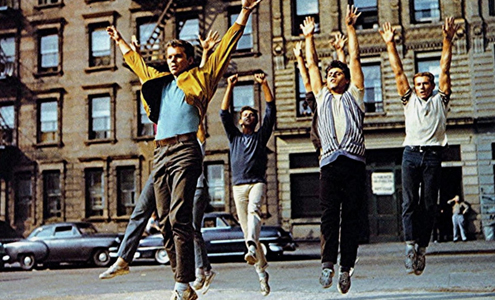

Respected production artist Maurice Zuberano, (whose credits include assistant director, second unit director and Production Associate) created all the storyboards, which were drawn on lightweight paper. Mr. Zuberano was chosen to supervise filming of the opening sequence, from a helicopter that had its door removed to accommodate the camera hanging down. At some point, a gust of wind swept up all of Zuberano's carefully drawn storyboards, and scattered them over Manhattan. Whoever might have found one of those drawings, would have no idea that they were holding an artifact of motion picture history.
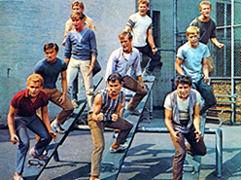

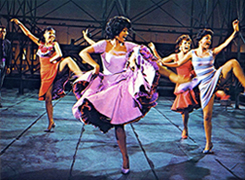
To sustain and build dramatic tension, Ernest Lehman's screenplay rearranged the musical sequences, moving lighter numbers "I Feel Pretty" and "Gee Officer Krupke" and "Cool" to play out before The Rumble. While the stage production had an intermission after The Rumble, Robert Wise reportedly has said he felt it would interrupt the tension in the film. WEST SIDE STORY has been most often shown straight-through, though it's been said that the original 70mm roadshow engagements included an intermission, after the scene in the candy store where Tony convinces the gangs to have a fair fight. Tony walks out of the store to the music of "Maria" and act one would end there. The entr'acte music was an instrumental of "I Feel Pretty." Act two opened with the scene at the bridal shop that leads into the song "I Feel Pretty."
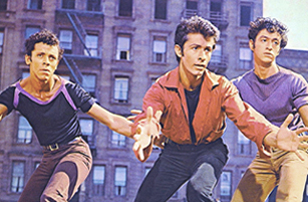
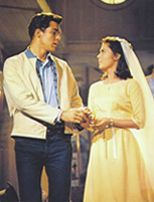

Further evidence of Saul Bass' creative brilliance comes in the way he created the main title sequence, which comes, (most unusually for that time) at the end of the film. The instructions warned operators not to close the curtains when "The End" comes on, as it is followed by five minutes of credits.
United Artists Premiered WEST SIDE STORY on October 18th, 1961 at the UA Rivoli Theatre on Broadway and 49th street in New York, NY.
The West Coast Premiere was on December 13, at Grauman's Chinese Theatre on Hollywood Boulevard in Los Angeles, CA.

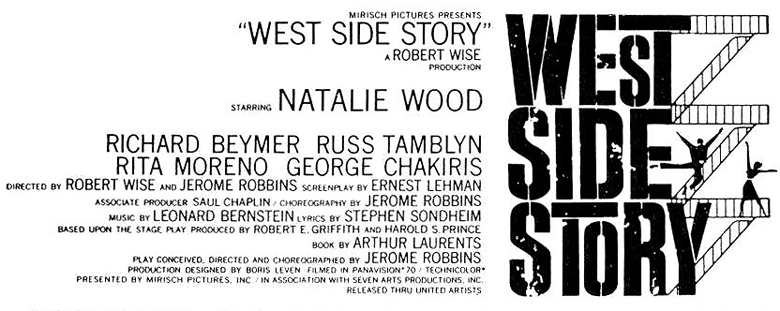

Written & Compiled by TJ Edwards
Image and additional Data Research by Greg Michael Pasqua
Images © Metro-Goldwyn-Mayer, inc. & Al Hirschfeld-Margot Feiden Galleries, ltd.


